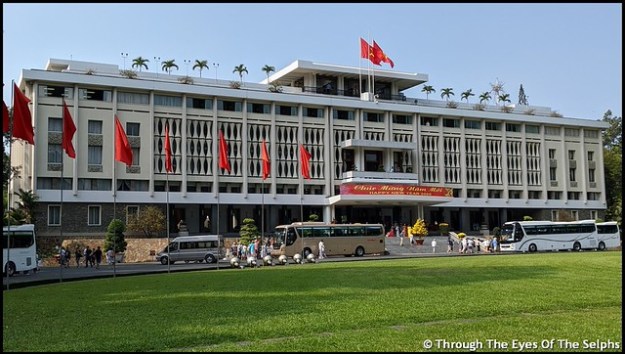The next stop was the former South Vietnamese Presidential Palace, now called Reunification Hall or Independence Palace. It was here on April 30,1975 the North Vietnamese burst through the gates in tanks, signaling the end of the Vietnam War. 


We had to climb many steps inside and it was stifling hot in the unairconditioned building. At 95 degrees, I was close to becoming overwhelmed by the heat. Inside were reception and dining rooms, the President’s private quarters and in the basement the old American made telecommunications equipment and strategic military maps still in place. 







Regardless of how hot and tired we were we had one more stop before lunch. This was at the History Museum with a collection of artifacts illustrating the evolution of the cultures of Vietnam. We did find a small gift shop where we were able to buy soft drinks which we quickly drank down in several gulps. 


It was now time for lunch and we were all more than ready, more from the need to rest in air conditioning rather than from hunger. We had lunch at a very nice five star restaurant with a buffet of Vietnamese delicacies.
When we went to the Happy Room we noticed a Smoking Room. We saw these at the Tokyo Airport and other places in Asia. If the cigarettes don’t kill you, the second hand smoke surely will! 
Next we stopped at a lacquer ware workshop to see how they make the beautiful lacquer based paintings and other objects. They actually use pieces of egg shells to color the paintings.


Finally to finish the day we drove by the beautiful Notre Dame Cathedral dating back to the 19th century and stopped at the post office with its lovely architecture. 

On the drive today Tony shared with us some of his thoughts on Vietnam. He said the government is very corrupt with lots of bribes. The people have to work very hard for an average salary of equivalent to $200 a month. The suicide rate among young people is very high. Alcohol and drug problems are widespread. He said there is a very large discrepancy between those who are wealthy and those who have nothing. While Vietnam has McDonald’s and Starbucks and KFC, most of the people have no money to pay for such things. There is no Social Security, no Medicare. He said the Vietnamese people love Americans and he named all the U.S. presidents who have visited and how many times they have visited. Around two thirds of the Vietnamese people living today have been born since the war was over in 1975. 


The lights here have timers to tell you when they are going to change.
After an hour drive back to the ship we were once again greeted with the much appreciated cold towels and lemonade. We rested for an hour before going out on the deck to see a special Vietnamese dragon dance put on for us by a group of thirty young men. A sort of thank you for visiting, please come back again farewell. After their performances they sat patiently on the pavement and waited for us to leave. The ship was delayed almost thirty minutes leaving as we waiting to clear Vietnam customs. As we finally began to pull away from the dock, the young men jumped up and began to dance again and wave goodbye. A lovely farewell to our first stop in Vietnam. 




































































































































































































